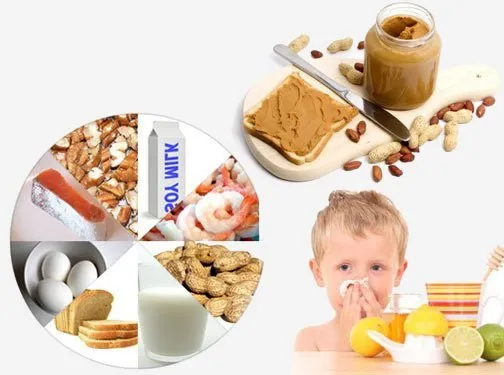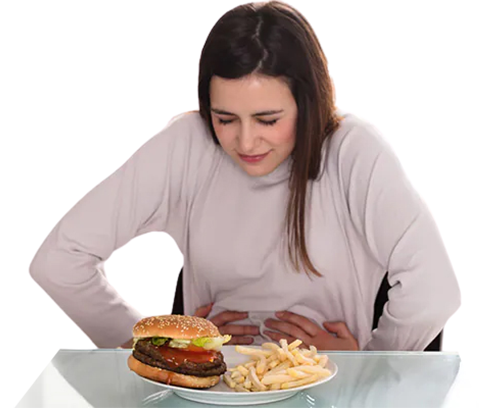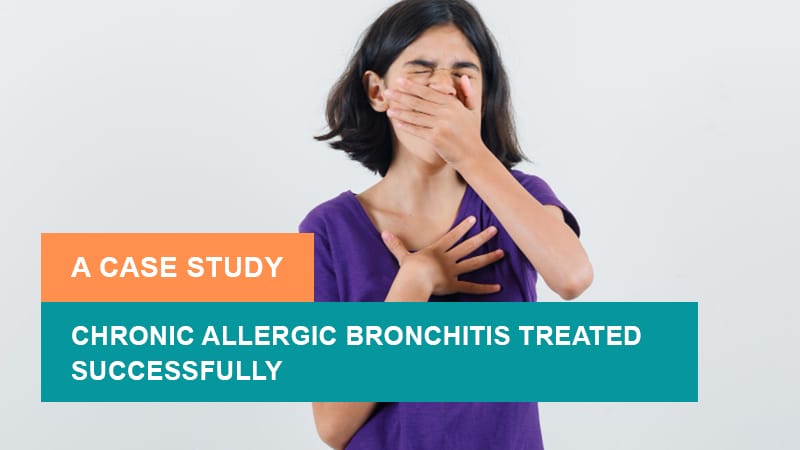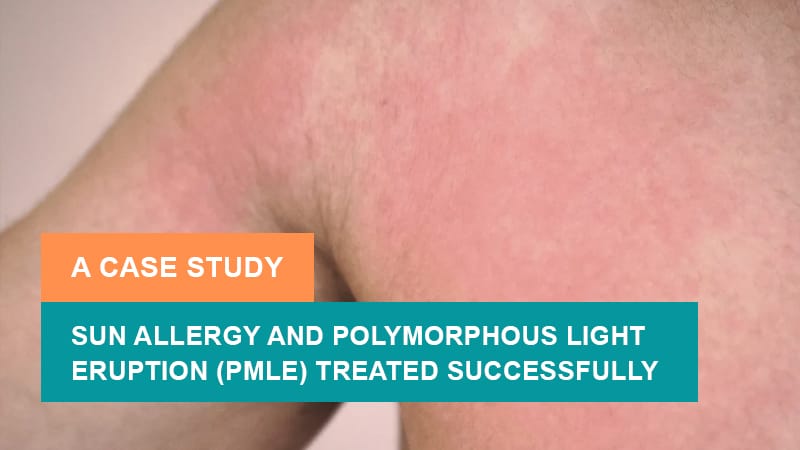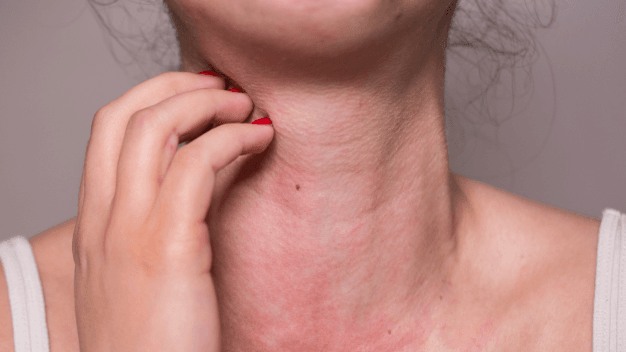On This Page
Introduction
What is Food Allergy?
Food Allergy refers to the hypersensitivity reaction of the body towards various types of food stuffs. The major etiology of food-related ailments are incompatible food habits or incorporation of foreign and unfamiliar food. The food allergies may show minor or acute symptoms. Even if individuals feel some discomfort after consumption of certain food, it may not be counted as a food allergy. Aahara Asatmyata or Virudha is the term mentioned in Ayurveda to denote Food Intolerance or Food Allergy.
Most people think that the food they eat is the culprit of food allergies. If someone has an allergy to some food and if they assume that its treatment is to “Just avoid that Food”, it is not the correct way of management. The “Culprit is not Food; the Culprit is Human Being itself”. The way humans do genetic mutation to crops, the way humans are using pesticides or herbicides, the way humans are using preservatives, the way humans are eating unnatural or synthetic foods, the way of cooking they had adopted like microwaves, etc. are the major causes for food-related discomforts. The most common among them is to have food combinations that are incompatible like dairy products with meat, milk with seafoods, etc.
Dr. Gupta’s IAFA suggests taking a detailed examination with an Ayurvedic allergy specialist for understanding the root cause behind the ailment. IAFA ensures the effective treatment of various food allergies.
Causes
What are the Causes of Food Allergy?
An allergy is caused when body’s immune system is inappropriately activated. The immune system is formulated to attack bacteria, viruses, parasites etc. Sometimes, body’s immune system reacts to certain food items. This is called “food allergy” or “food intolerance. ”When the immune system is activated, antibodies or immunoglobulin are produced against antigen or allergen. Antigen-Antibodies reaction, in turn, triggers an inflammatory response. Inflammation causes pain and tissue damage, leading to increased mucous production. Further, symptoms like rash, itching, or severe allergic reaction called anaphylaxis may occur.
When food is eaten is broken down and absorbed by the gastrointestinal system, it is distributed through the bloodstream to all body tissues. Therefore an allergic reaction can occur just anywhere in the vascular body.
Ayurveda suggests that the reasons for food allergy include intake of incompatible food items, unfamiliar food, improperly cooked food, untimely food etc. Ayurveda outlines a number of foods that on combination may become unhealthy and ill effecting. Combinations of some rasa are incompatible like madhura (sweet) with amla (sour), madhura with tikta (bitter), etc.
Causes of food allergy are divided into three parts as per dosha dominance:-
- Vata-Related Reasons in Food Allergy – Vata gets aggravated in Vata dominant body type people by consuming spicy, dry, bitter, astringent, raw, and cold food items.
- Pitta-Related Reason in Food Allergy – Pitta gets aggravated in Pitta dominant body Type people by consuming excessive spicy, sour, salty, fermented, deep-fried food items, raw vegetables, etc.
- Kapha-Related Reason in Food Allergy – Kapha gets aggravated in Kapha dominant body type people by consuming excess milk products, excess sweets, sour, salty, cucumber, watermelon, cold items.
Classification of Food Allergy
Any food can cause an adverse reaction. But according to the International Standards, eight types of food are considered as the reason for about 90 percent of food allergy events. They are:
- Eggs
- Milk
- Fish
- Shellfish
- Peanuts
- Tree Nuts
- Wheat
- Soy
Certain seeds, including sesame and mustard seeds (the main ingredient in the condiment mustard) are also common food allergy triggers and are considered as major food allergens in India.
In Ayurveda, on the basis of dosha dominance, food allergies are classified into:
- Vata Related Food Allergy
- Pitta Related Food Allergy
- Kapha Related Food Allergy
Ayurvedic Reference of Food Allergy (Aahara Asatmyata)
यत्किञ्चित्दोषमुत्क्लेश्यनहरेत्तत्समासत: l
विरुद्धं ……………………………………….l l
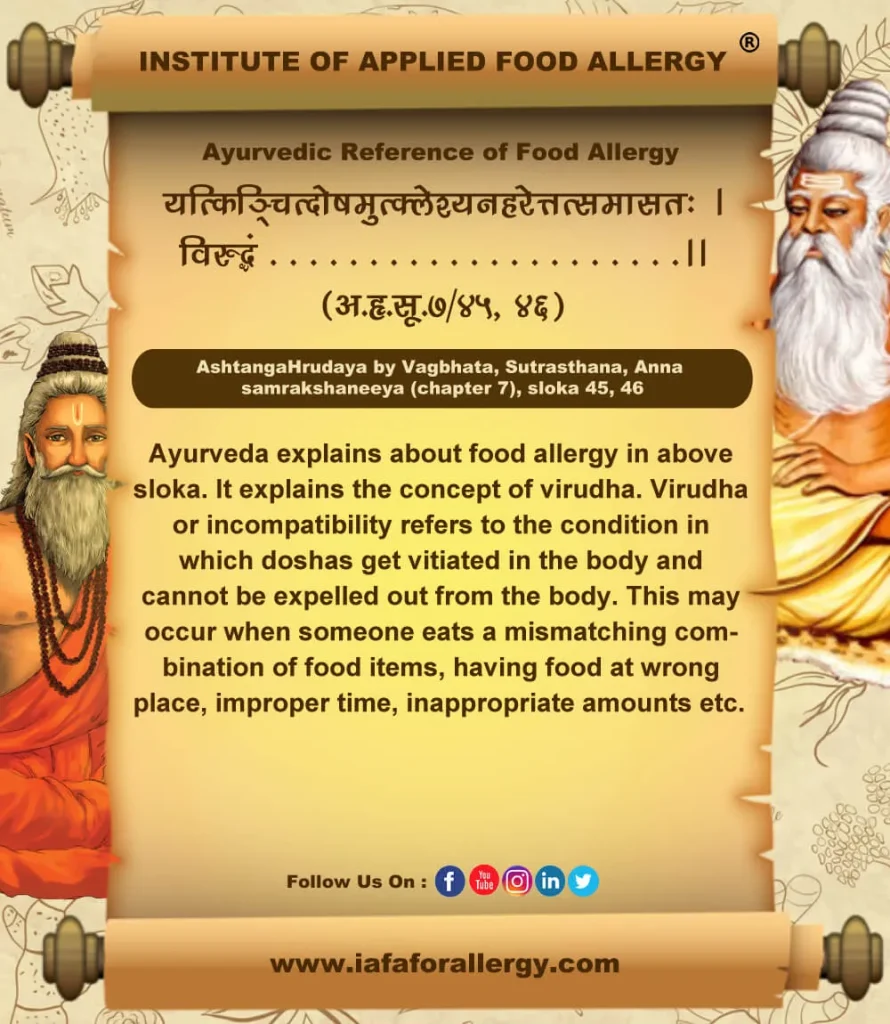
Symptoms
What are the Symptoms of Food Allergy?
Mostly food allergy symptoms occur within two or three hours of ingestion or often start within minutes in some patients. Delayed reactions by four-six hours or even longer are typically seen in children who develop eczema or any other skin related ailment as a symptom. Some common symptoms that can help to diagnose food allergies are:
- Vomiting and stomach cramps
- Hives and angioedema
- Shortness of breath
- Wheezing sound in lungs
- Low blood pressure
- Shock or circulatory collapse
- Throat congestion; difficulty during swallowing
- Repetitive cough
- Repetitive cough
- Swelling of the tongue, difficulty during the talk
- Weak pulse
- Pale or blue coloring of skin (Cyanosis)
- Dizziness or feeling faint
- Anaphylaxis – a potentially life-threatening reaction
- Food Protein-Induced Enterocolitis Syndrome (FPIES) – a severe gastrointestinal reaction.
Symptoms of Food Allergy according to Ayurveda are explained on the basis of type dosha vitiation.
- Vata Related Signs in Food Allergy: Bloating stomach, flatulence, nerve pain, tingling sensation, loss of sleep, twitching muscles, joint pain.
- Pitta Related Signs in Food Allergy: Urticaria, allergic dermatitis, eczema, diarrhea, and pustule formation.
- Kapha Related Signs in Food Allergy: Asthma, sinusitis, bronchitis, rhinitis, cold, cough, sleeping disorders.

“Our digestive system is designed to work on wholesome and compatible food. The food that we eat determines our state of health and Illness. The use of unfamiliar and unaccustomed food items will disturb our digestive system and result in various allergic manifestations. Have a healthy diet and own healthy life. IAFA is always at your help for the prevention as well as management of all types of Food Allergies”.
IAFA holds your hand for an allergy-free and healthy life!
– Dr. Sahil Gupta (B.A.M.S., M.H.A.)
Ayurvedic Allergy Specialist
CEO & Founder of IAFA®
At last, Easier Food Allergy Management

Trusted by
More than 90,000 Patients

Convenient
at-Home Treatments

9.2 / 10
Customer Satisfaction Score
Ayurvedic Concept of Food Allergy (Aahar Asatmya)
The term Satmya is used in Ayurveda which means tolerance to anything. The term used Asatmya means Intolerance to something. Satmya and Asatmya towards any food, weather or any habit is basic principle in terms of food allergy in Ayurveda. Thus Aahar Asatmya term in Ayurveda is a defined as Food Intolerance or Food Allergy. Asatmya is a result of weak digestive fire or agni. Body’s digestive fire (agni) becomes weak due to ama visha (toxin) formation in the body because of imbalance in body doshas (Vata, Pitta, Kapha are life forces). Maximum allergic problems are common in people whose body contains ama visha (toxins) in the body. Aam visha the hard rock that originates first and then gradually accumulates in your body is due to ingestion of food in inadequate combination that is asatmya aahar.
Adequate Food Combination the Ancient Eating Principle of Ayurveda
The digestive tract and immune system are interlinked, adequate food combination (historical as per Ayurveda principles) can provide essential support by helping us to improve digestive health, which in turn can improve immune health.
Ayurveda divides Food (Ras) Tastes into two Group 1 and Group 2 as below:
| Food (Ras) Six Tastes of the Tongue | |
| Group 1 | Group 2 |
| 1. Madhura (Sweet) – like sugar, honey, sugarcane juice, rice, wheat, milk, and fruits like mango | 4. Katu (Pungent) – like Chili pepper, and black pepper, spices such as mustard, ginger, garlic, and onion |
| 2. Amla (Sour) – Citrus fruits like limes, lemons, oranges, sour cream, yogurt, vinegar & fermented food. | 5. Tikta (Bitter) – like bitter gourd and bitter melon, Herbs like neem. |
| 3. Lavana (Salty) – Sea salt, rock salt, and table salt | 6. Kashaya (Astringent) – like Unripe banana, chickpeas, alum, and okra. |
Ayurveda outlines a number of foods that, while perhaps fine to eat individually. The three ras of same group 1 madhur, amla and lavan are incompatible to eat with one another like madhura with amla and are compatible to eat with another three ras of different group 2 katu, tikta and kashya like madhura with tikta. Inadequate combination (virudha aahar) of ras (food) leads to food allergies. That’s the ancient principle of aahar-vihar of ayurveda.
Ayurvedic Treatment for Food Allergy
How to Treat Food Allergy?
Ayurveda provides effective treatments for food allergies that are specifically caused by certain proteins found in food items. The Ayurvedic treatment protocol is unique and it includes various procedures and medicines used internally as well as externally. The combined therapy of all these ensures a complete cure for allergic reactions.
Internal Medicines
The following medicines can be recommended for food allergy treatment according to the condition of the patient.
- Patoladi Kwatha
- Vilwadi Gulika
- Kaisora Guggulu Gulika
- Dooshivishari Gulika
- Dasamoola Haritaki Lehyam
- Manibhadra Gulam
- Punarnavasavam
- Mustharishtam
- Kutajarishtam
- Abhayarishtam
- Dasamoolarishtam
- Jeerakarishtam
External Medicines
The following medicines can be given for food allergy treatment during external procedures. Medicines and their method of use depend on the condition of the patient as well as the stage of the allergy.
- Eladi Gana Choornam
- Triphala Churna
- Vilwadi Gulika
- Dinesavalyadi Kera
- Nalpamaradi Keram
- Nimbadi Choornam
- Manjishtadi Kwatham
- Aragwadhadi Kwatham
- Guduchyadi Kwatha
External Procedures
Various procedures as explained below can be administered in patients suffering from food allergy as and when required.
- Lepana (Application of medicinal paste)
- Abhyanga (Oil massage)
- Dhara (Pouring medicated water)
- Kshalana (Washing with medicated liquids)
- Swedana (Sweating therapy)
Purification Therapy
Various purification procedures are done based on the age and health status of each patient. Purification therapies help to expel vitiated doshas and toxins from the body. They include:
- Vamana (Emesis)
- Virechana (Purification)
- Vasti (Enema)
- Raktamoksha (Blood-letting)
- Nasya (Nasal administration of medicines)
Single Herbs in Food Allergy
Judicious use of various medicinal herbs helps in the management of various allergic reactions. Following are some single herbs that are proven to have a tremendous effect on the treatment of Food Allergy.
- Haridra (Curcuma longa)
- Khadira (Acacia catechu)
- Rakta Chandan (Pterocarpus santalinus)
- Aragvadha (Cassia fistula)
- Yashtimadhu (Glycyrrhiza glabra)
- Guduchi (Tinospora cordifolia)
- Sirisha (Albizia lebbeck)
- Punarnava (Boerhavia diffusa)
- Manjishta (Rubia cordifolia)
- Nimba (Azadirachta indica)
Diet and Lifestyle
What to Eat and What to Avoid in Food Allergy?
Pathya (Do’s)
- Consume properly cooked food
- Drink sufficient quantity of water
- Include bitter, mildly spicy food.
- Consume warm and fresh food.
- Include herbal tea with ginger, cumin, and lemon in the diet
- Use warm water for drinking and external use
- Take food on time
- Avoid bathing just after food
- Include fruits and vegetables in the diet
- Mild exercises (Eg: Brisk walk 20 minutes/day)
- Adequate sleep
- Proper toweling after head bath
- Working atmosphere should be open and or properly ventilated
Apathya (Don’ts)
- Excessively spicy, salty and sour food
- Fermented food
- Cold and refrigerated food
- Diary products like cheese, milk, yoghurt.
- Avoid excess of sweet, sour, salty tastes
- Day sleep
- Late night work
- Junk food
- Regular restaurant food
- Fried and bakery food
- Mixture of different types of food
- Mixture of non-vegetarian food with milk and other sweet items
- Alcohol consumption
- Cigarette smoking
- Raw food
- Travelling to places with high humidity
- Having food before digesting previous meal
- Sedentary life style without exercise
- Mental stress
- Regular use of A/C room
Yoga and Pranayama for Food Allergy Treatment
Yoga is an effective stress management technique that helps to get relaxed and to achieve control over the mind and emotions. Yoga regulates the body’s immune system and controls various allergic reactions. Following yoga procedures are especially beneficial in Food Allergy:
- Halasana
- Matsyasan
- Sarvangasana
- Suryanamaskar
- Adhomukhasvanasana
- Shalabhasana
- Pavanamuktasasana
- Savasana
- Sukhasana
- Padmasana
- Bhujangasana
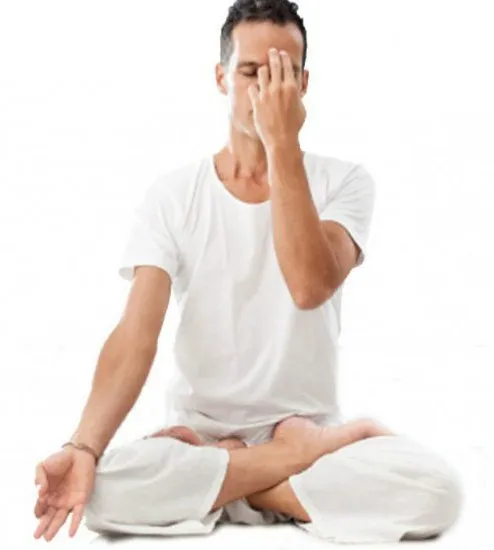
Frequently Asked Questions
Question: How do you treat a food allergy?
Answer: Food allergies can be best treated by using natural herbs and Ayurvedic remedies like Aahar Amrutham Ras and Aahar Amrutham Gulika they help in eliminating the root cause of the disease, balancing the Tri Doshas, and preventing your further recurrence of the disease.
Question: What is the best treatment for a food allergy?
Answer: Ayurvedic medicine and other Ayurvedic therapies like panchakarma is the best treatment for food allergy because it helps in the elimination of the root cause of the disease, prevents you from recurrence and alleviates symptoms of food allergies.
Question: What is the fastest way to get rid of food allergies?
Answer: Keeping away from the food that’s causing the symptoms is the fastest way to get rid of food allergies. Adding to prescribing ayurvedic medications, therapies (panchakarma) like Vamana, Virechana, Basti for balancing gastrointestinal tract also works the best for treating food allergies.
Question: Which tablet is best for food allergies?
Answer: Aahar Amrutham Gulika is one of the best tablets for food allergies. Aahar Amrutham Gulika is made of Vacha, Musta, Parpata and Bilva which play a key role in alleviating the symptoms of food allergies. Along with using Changeri Capsules, it is always best to avoid foods that trigger food allergies.
Question: How long will food allergies last?
Answer: In some individuals Food Allergies and its symptoms can last for a longer period of time. Some will persist permanently and require precise treatment to cure them. Food allergy can be well managed by Ayurveda medicines and therapies.
Question: How can I control my food allergies at home?
Answer: Food allergies can be controlled at home by avoiding the foods that trigger allergic reactions and following digestant and appetizers like cumin water and fennel water. If you’re looking for natural treatment, You don’t even need to step out and can even book an online consultation with Dr Sahil Gupta who’s an expert in treating food allergies.
Question: What is the best home remedy for food allergies?
Answer: Drinking Bilva Juice (Aegle Marmelos) Golden Apple with Sunthi powder and jaggery which are good digestants, rich in antioxidants, has anti-inflammatory properties, works on Gastrointestinal tract balance and alleviates food allergies. Eating low histamine foods and a well balanced diet is the key to getting rid of food allergies.
Question: What helps food allergies go away?
Answer: Food allergies can go away with a personalised Ayurvedic treatment plan. Stopping the triggered foods can reduce the symptoms and allergic reactions. Later you can proceed with other home remedies, dietary changes and lifestyle modifications.
Question: Can a food allergy be cured?
Answer: Ayurveda has a solution for food allergy. Ayurveda says that treating the disease from root cause helps in curing the food allergy. Using Ayurvedic herbal medicines, following an Ayurvedic diet and practising certain Ayurvedic therapies like panchakarma can help to cure food allergies.
Question: How do you treat food allergies naturally?
Answer: Food allergies can be naturally treated by avoiding the triggered foods and incorporating a low-fat and low histamine diet rich in carbohydrates, whole grains, vegetables, fresh fruits, nuts, vitamin C-rich foods and plenty of fluids that can avoid allergic reactions and reduce inflammation.
Question: Is there a permanent cure for food allergies?
Answer: Everyone says there is no permanent cure for food allergies, but not Ayurveda. Ayurveda firmly believes that food allergies can be best treated by finding out the root cause and treating it. Ayurveda medicines work on digestive stimulation, enzymatic action balancing, disintegration of food, absorption of food and elimination of proper waste.
Question: What is the cure for food allergies?
Answer: IAFA ensures that food allergies can be cured through 5000 years old ancient Ayurvedic science. First, differentiate that allergies are caused due to natural food or synthetic foods that contain herbicides, food additives, preservatives, artificial colour and sweeteners. As per ayurveda wrong food combination, untimely food, unfamiliar food can be a cause of food allergies.
Question: What food allergy causes itchy skin?
Answer: Any food can trigger pruritic skin diseases. Food allergies are route causes in various allergic manifestations. The progression of allergic disorder is called the Allergy March. The progression starts with Atopic dermatitis (Eczema), the first step in atopic march and ends with Allergic Rhinitis (Hay Fever) and Asthma.
Question: What to eat with multiple food allergies?
Answer: People with food allergies must avoid the triggering foods and should eat foods that are light, easily digestible, natural and fresh foods, home prepared meals, nutritious foods, fresh fruits and vegetables, nuts and whole grains (if not allergic), fresh fruit juices with pulp and no sweeteners and warm foods. It’s better to keep the plate filled with greens, warm and easily digestible meals.
Question: What food allergy causes itchy skin?
Answer: Any food can trigger pruritic skin diseases. Food allergies are route causes in various allergic manifestations. The progression of allergic disorder is called the Allergy March. The progression starts with Atopic dermatitis (Eczema), the first step in atopic march and ends with Allergic Rhinitis (Hay Fever) and Asthma.
Question: What are the reasons for increasing occurrence of Food Allergy?
Answer: Due to inappropriate food combination allergy has increased so rapidly in recent years, significantly in young kids. It can be probably due to changes in life style leading even to genetic changes.
Question: Are all food allergies severe?
Answer: No. Fortunately, the majority of food allergies are not dangerous. Mild symptoms include hives, sickness in the stomach or vomiting. However, symptoms such as difficulty in breathing due to throat swelling or asthma, or dizziness due to a drop in blood pressure, indicate a potentially life threatening severe allergic reaction called anaphylaxis.
Question: What happens if the allergic food is used continuously?
Answer: It can cause severe symptoms and can even lead to a life-threatening reaction.
Question: What is gluten intolerance?
Answer: Gluten intolerance is not an allergy. Gluten is a type of protein found in most of the grains, like wheat, oats, triticale, barley and rye. Some persons might be allergic to wheat, but he or she may not be having gluten intolerance. Gluten allergy is a misleading term many people’s commonly confused with wheat allergy, or may sometimes with celiac disease. There is no such thing as a gluten allergy, but there is a condition called Celiac Disease. Celiac Disease is a digestive condition in which after eating gluten-containing products, a rash, severe diarrhea, severe weight loss or failure to properly gain weight, and abdominal pain occurs, that is potentially serious if not diagnosed or treated.
Question: Is Ayurvedic treatment effective for food allergy?
Answer: Yes. Ayurveda is effective in the management of food allergy. Ayurveda has combination of internal as well as external therapies and purification therapies to get rid of all allergies.
Question: Are there any foods that should be avoidedto feed children when solids are introduced?
Answer: IAFA recommends the introduction of complementary solid food around six months. It should not be given before four months and ideally breastfeeding is to be continued. After six months, familiar, easily digestible, common food items can be introduced. Meat, fish, egg, sea food, wheat, soy etc. should be avoided in initial stage.
Question: Are all reactions to milk caused due to allergy?
Answer: No. Lactose intolerance is a condition caused by the lack of the enzyme lactase, which helps to digest the milk sugar lactose. The symptoms include diarrhea, vomiting, stomach pain and gas, which are similar to some of the symptoms of milk allergy. This condition is uncomfortable but not dangerous, and does not cause symptoms of food allergy such as hives, swelling or anaphylaxis. In lactose intolerance, small amounts of cow’s milk are usually tolerated, and yogurts and hard cheeses are usually better tolerated than milk, as they contain less or easier to digest lactose than cow’s milk.
Question: Are allergic reactions to inhaled food allergens common?
Answer: No. Allergic reactions to food in the form of air borne or fine dust are very uncommon. Mostly all food proteins are quite heavy and do not easily disperses as aerosols. Sometimes people with severe food allergies find that even the smell of foods can trigger symptoms. Fortunately, this is a relatively rare complaint and symptoms that are almost never dangerous or severe.
Question: Can I use a hand sanitizer to remove food allergen from my hands?
Answer: When it comes to avoidance or minimization of allergen, the aim of hand washing is to remove allergens rather than to disinfect. Soap and water are ideal, but if they are unavailable hand sanitizer or wipes may be used. Liquid sanitizer (not wipes) that is not rinsed off is not recommended.
Question: What is Pollen Food Syndrome?
Answer: About 1 in 10 people with allergies to some grass or tree pollens will complain that some uncooked vegetables or fresh fruits and nuts will make their mouth and throat itchy or swell. This is known as Pollen Food Syndrome (also known as Oral Allergy Syndrome). In this condition, people are allergic to proteins that are present in pollens as well as these foods. Usually the allergy to the pollens precedes the food allergy symptoms. If the food is heated, the protein is often destroyed, as the cross reactive proteins in pollens and food are often quite fragile. This is why many people with PFS can eat the cooked food without a problem. It is rare to have serious allergic reactions in PFS, but some foods which commonly cause PFS can also cause normal food allergy and can give rise to anaphylaxis. It is important that your doctor confirms what type of food allergy you or your child suffers from.
Question: Is Oral Allergy Syndrome or Pollen Food Syndrome is food allergy?
Question: Is Oral Allergy Syndrome or Pollen Food Syndrome is food allergy? Answer: This can be not a food allergy, though the symptoms occur from food you eat, which might be confusing. This is a pollen allergy. The symptoms of oral allergy syndrome are generally short-lived and are itchy mouth or tongue, or swelling of the lips or tongue. These symptoms because of cross-reacting allergens found in both pollen and raw fruits, vegetables, and some tree nuts are quickly digested, and do not involve any other part of the body, so cannot be accounted in food allergy.
Question: Can food allergies develop in adult age?
Answer: Yes, Shellfish – Crustaceans and Mollusks, as well as tree nuts, and peanuts are most food allergies develop in adults. The symptoms such as vomiting or diarrhea can be mistaken for the flu or food poisoning.
Question: Is my child’s food allergy will be lifelong?
Answer: No. This is an important question in every parents’ mind. Children most probably, but not always, outgrow allergies to some food like milk, egg, soy and wheat. Almost 30 percent of children may outgrow their peanut allergy, with slightly fewer expected to outgrow a tree nut allergy. There is no need to take tension that your child’s food allergy will be lifelong, though for many, this may be the case.
Question: What is FPIES?
Answer: FPIES is Food Protein-Induced Enterocolitis Syndrome (FPIES), a severe gastrointestinal reaction that generally occurs two to six hours after consuming any untolerated food like milk, soy, certain grains and some other solid foods. It mostly occurs in young infants who are being feeder to these foods for the first time in life. FPIES babies often involve repetitive vomiting and can lead to dehydration or in some cases, will develop bloody diarrhea. Diagnosis of FPIES may be difficult, because the symptoms resemble those of a viral illness or bacterial infection, FPIES is a medical emergency.
Question: What does Ayurveda say about food allergies?
Answer: Ayurveda believes that food allergies originate from an imbalance in the doshas leading to low digestive fire and accumulation of toxins.
Question: Can Ayurveda treat food allergies?
Answer: Ayurvedic treatment under the guidance of an expert seems to be promising in the successful management of food induced allergic reactions.
Question: What is the cause of food allergy?
Answer: According to Ayurveda, food allergy is caused due to the intake of foods having antagonistic properties. One example is taking fish with milk and asatmyaahara (food intolerance).
Question: What is the Ayurvedic treatment of Food Allergy?
Answer: The Ayurvedic treatment of food allergy is hugely emphasized on the health of digestive system as the digestive strength is intricately linked to the immune response. So, firing up the digestive capacity can be tremendously helpful when it comes to allergies.
References
- Prasad Mamidi, Kshama Gupta (2017) Ayurvedic management of Dermatographism. Indian Journal of Ancient Medicine and Yoga 10(1): 33-35.
- Gangal SV, Malilk BK (2003) Food Allergy – How much of a problem really is this in India? J Sci Ind Res 62 (08): 755-765.
- Ayurvedic Aspects of Allergies and Fungal Infections, Edition 2021, by Sahil Gupta, Food Allergy, Chapter No. 15, Page No. 92-100.
Dr. Gupta IAFA is the pioneering Ayurvedic institute for the management of various types of allergies. IAFA ensures a healthy life through Ayurveda and keep you protected from allergic distresses.
IAFA holds your hand for an allergy free and healthy life !
Was this Page Helpful?
So IAFA Root-Cause Treatment for Food Allergy is Just 3 Steps Away!

01. Connect With Us
Share your history of illness or Book your appointment

02. Consult With Us
Dr. Gupta a certified Ayurvedic Allergist Consultant

03. Root Cause Treatment
Get an accurate diagnosis, medicines, diet & lifestyle change
Real Case Studies – Successfully Treated Patients
Real Case Studies of Successfully Treated Patients from All Around the World by IAFA Ayurveda®

9 Year Old Female Patient Recovered from Chronic Allergic Bronchitis – A Case Study
This case study presents a 9-year-old female patient who has successfully recovered…

12-Year-Old Child Recovered from Sun Allergy and Polymorphous Light Eruption (PMLE) – A Case Study
This is a case study of a 12-year-old child who has successfully…

40-Year-Old Female Patient Recovered from Dyshidrotic Eczema and Onychomycosis – A Case Study
This case study highlights the successful recovery of a 40-year-old female patient…

40-Year-Old Female Patient Recovered from Urticaria and Angioedema – A Case Study
This case study focuses on a 40-year-old female patient who has successfully…
Read More Articles

Mast Cell Diseases
Discover Ayurvedic treatment for Mast Cell Diseases, including types, causes, symptoms, and…

High Immunoglobulin-E (IgE) Levels
Discover Ayurvedic treatment for high Immunoglobulin-E (IgE) levels. Learn about the causes,…

Histamine Intolerance
Discover Ayurvedic treatment for histamine intolerance, its causes, symptoms, and natural treatment.…

